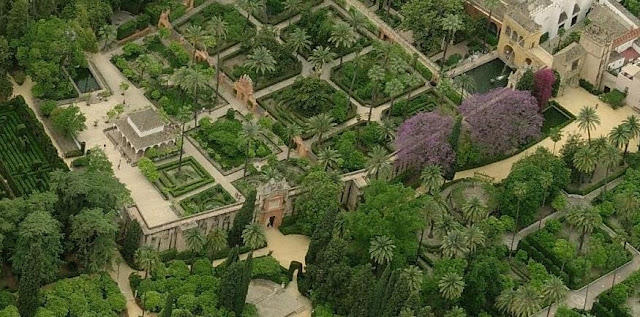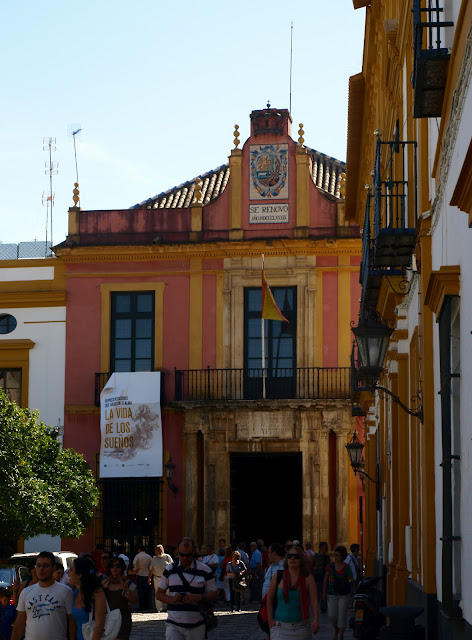En la capilla gótica del Alcázar sevillano podemos ver este retablo dedicado a la Virgen de la Antigua.
Esta imagen de la virgen, de influencia claramente bizantina, es la que se utiliza en todo el mundo para representar iconográficamente a la virgen bajo la advocación de Virgen de la Antigua.
La Virgen se encuentra en pie y posición frontal, vistiendo túnica y un manto que le cubre completamente la cabeza. Su rostro, de mirada al frente, aunque levemente girada hacia el niño en una amable actitud.
Sostiene delicadamente en su mano derecha una rosa, mientras carga en su brazo izquierdo al Niño, que juega con un jilguero.
Sobre la cabeza, dos ángeles se disponen a coronarla, en tanto otro ángel, más arriba, extiende una cartela en la que se lee la frase evangélica "Ecce María venit ad Templum" en una alusión a la festividad de la purificación. El fondo de la imagen es dorado.
Esta es la información objetiva. Ahora, dejando volar la imaginación, podemos echar mano de la leyenda. Una leyenda sevillana en la que se dice que el Rey Fernando III de Castilla durante el asedio a la ciudad para su conquista, estando en el campamento, se postró ante la Virgen de los Reyes para pedirle auxilio. Siendo entonces cuando la Virgen lo llamó por su nombre y le dijo: "Tienes una constante protectora en mi imagen de la Antigua, a la que tú quieres mucho y que está en Sevilla", prometiéndole la victoria.
Después, un ángel le hizo penetrar en la ciudad hasta llegar a la mezquita principal en cuyo interior le fue mostrada la pared que la ocultaba, que se volvió trasparente, tal como el cristal, y Fernando III pudo contemplar la imagen de la Virgen tal como había sido pintada siglos atrás.
In the Gothic chapel of the Sevillian Alcazar we can see this altarpiece dedicated to the Virgin of the Antigua.
This image of the virgin, with Byzantine influence is the one that is in use in all the world for representing iconographic the virgin under the dedication of Virgin of the Antigua.
The Virgin is on foot and frontal position, dressing tunic and a mantle that covers completely the head. Her face though slightly turned towards the child in a nice attitude.
She supports delicately in her right hand a rose, while she loads in her left arm the Child, who plays with a goldfinch.
This image of the virgin, with Byzantine influence is the one that is in use in all the world for representing iconographic the virgin under the dedication of Virgin of the Antigua.
The Virgin is on foot and frontal position, dressing tunic and a mantle that covers completely the head. Her face though slightly turned towards the child in a nice attitude.
She supports delicately in her right hand a rose, while she loads in her left arm the Child, who plays with a goldfinch.
On the head, two angels prepare to crown her, while another angel, a little bit above, extends a document in which the evangelical phrase is read "Ecce Maria venit ad Templum" in an allusion to the festivity of the purification. The bottom part of the image is gilded.
This one is the objective information. Now, ising the imagination, we can read this legend.
A Sevillian legend that said that the King Fernando III of Castile during the siege to the city for the conquest, being in the camp, prostrated himself before the Virgin of the Kings to ask for aid him.
Being at the time when the Virgin called him by his name and said to him: "You have a protective constant in my image of the Antigua, to which you want very much and which is in Seville", promising him the victory.
This one is the objective information. Now, ising the imagination, we can read this legend.
A Sevillian legend that said that the King Fernando III of Castile during the siege to the city for the conquest, being in the camp, prostrated himself before the Virgin of the Kings to ask for aid him.
Being at the time when the Virgin called him by his name and said to him: "You have a protective constant in my image of the Antigua, to which you want very much and which is in Seville", promising him the victory.
Later, an angel made him penetrate in the city up to coming to the principal mosque in whose interior there was showed him the wall that was concealing, that turned trasparent, such as the crystal, and Fernando III could contemplate the image of the Virgin as it had been done centuries behind.





























.JPG)








.JPG)
.JPG)
.JPG)
.JPG)
.JPG)
.JPG)






.JPG)